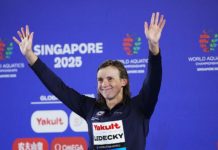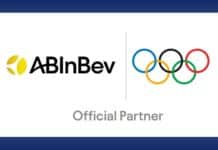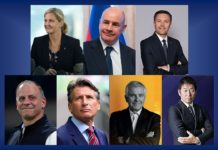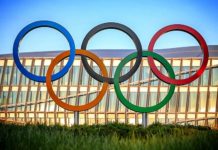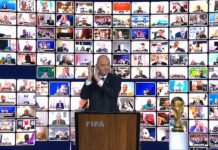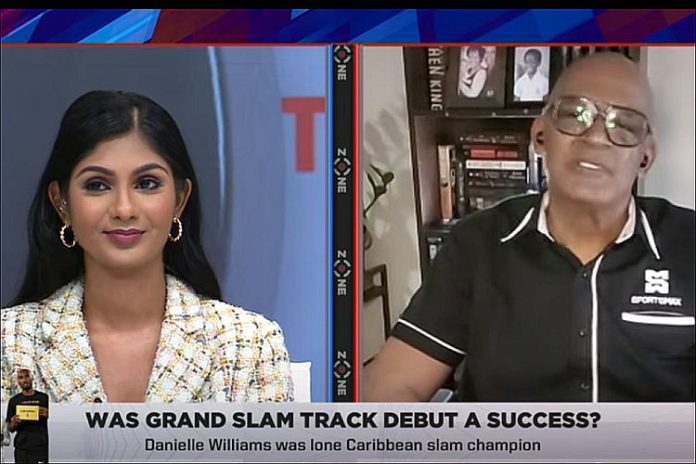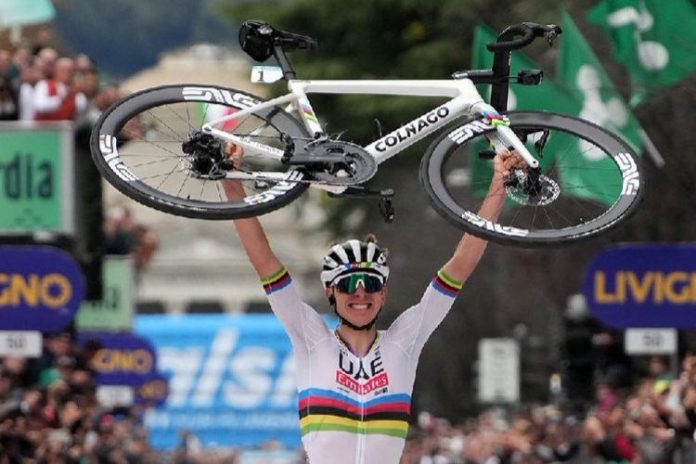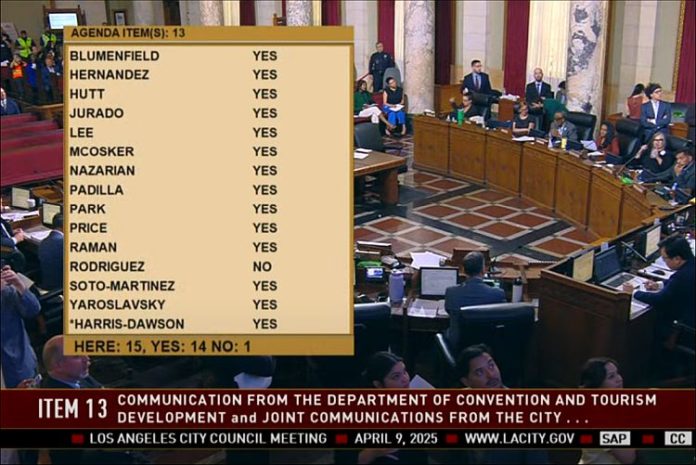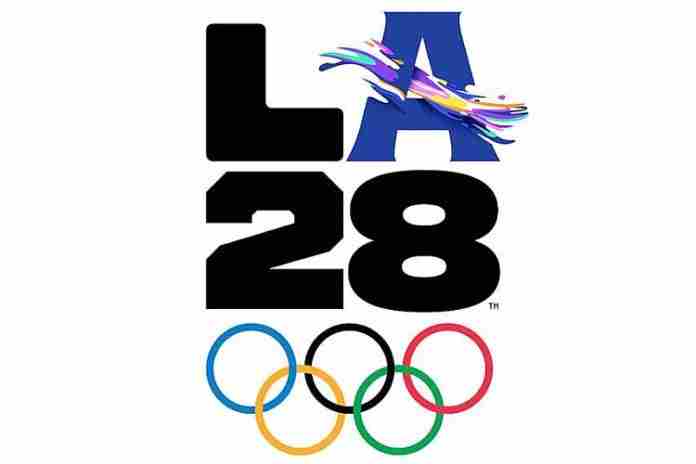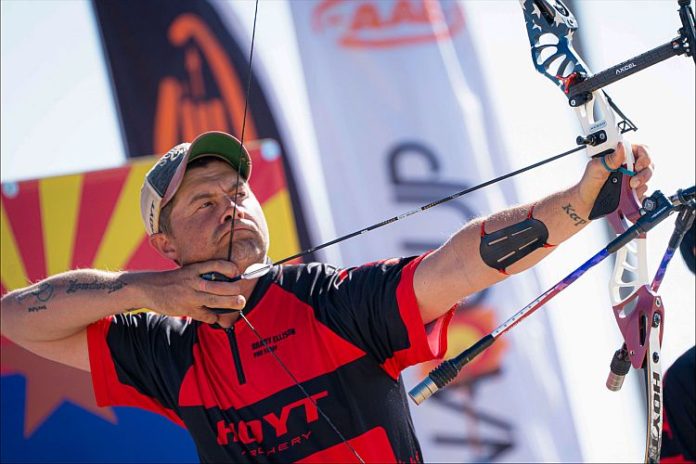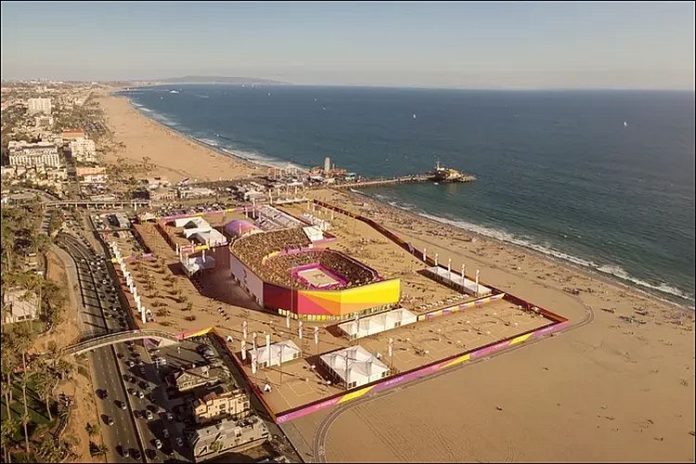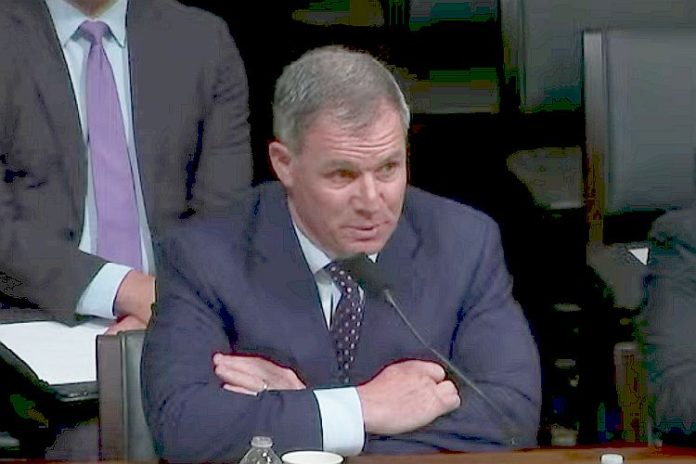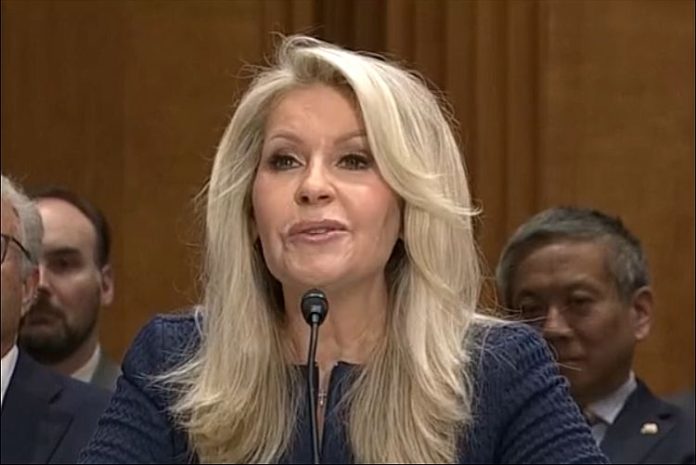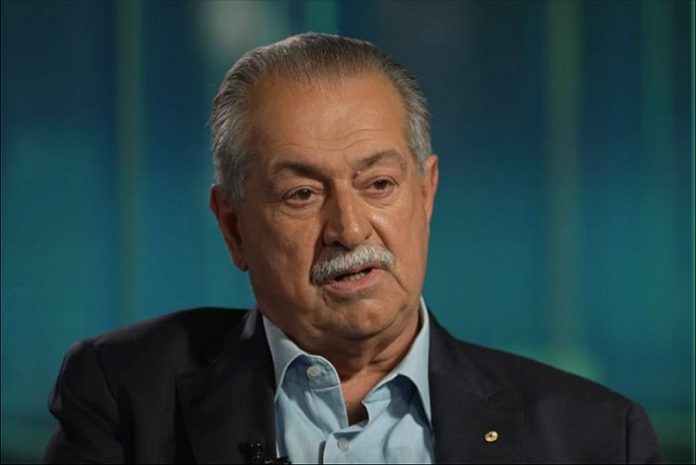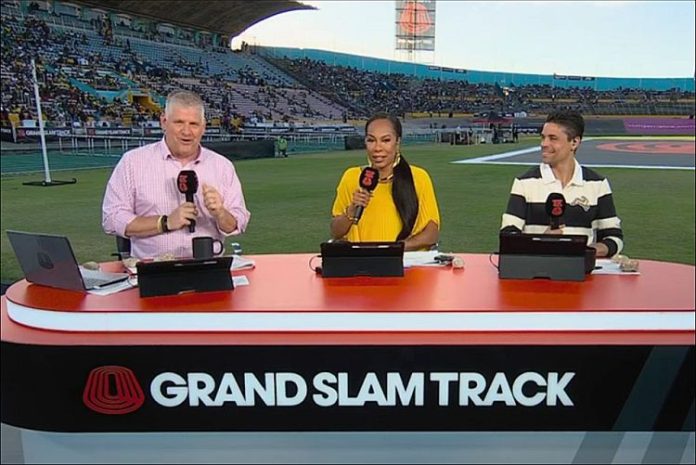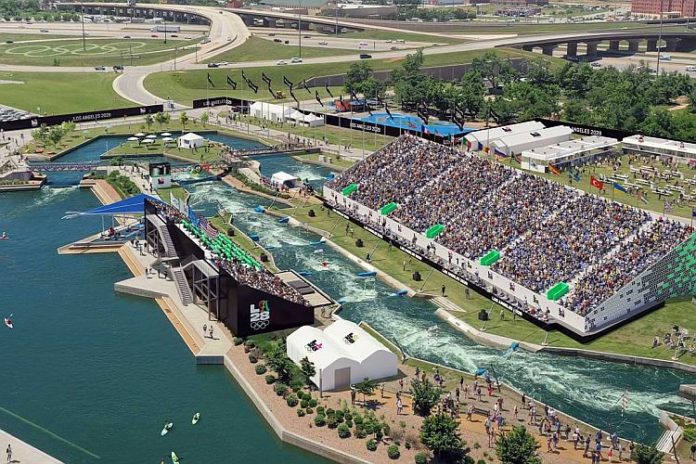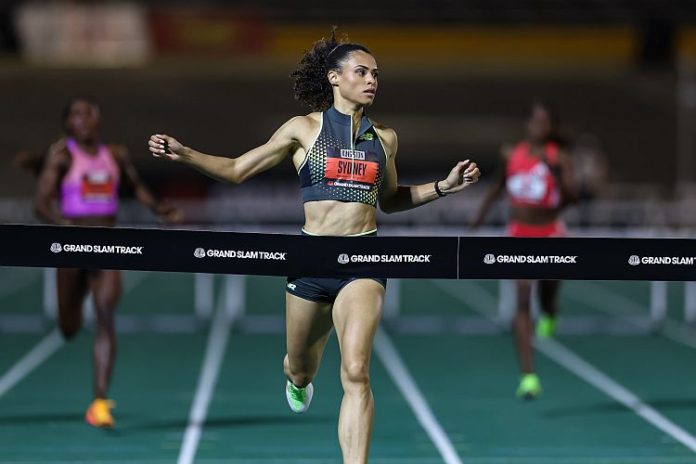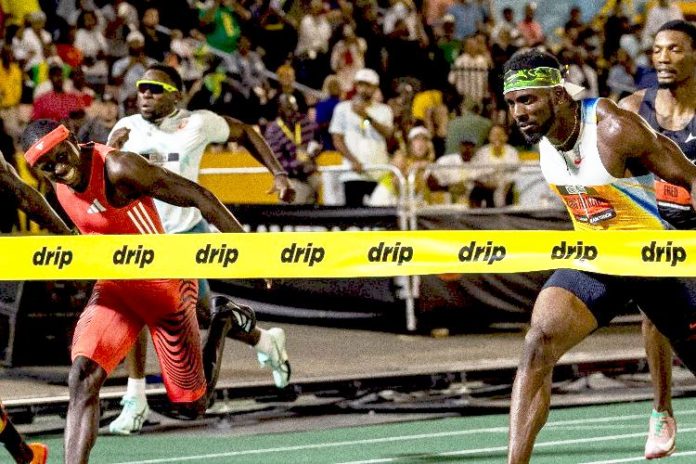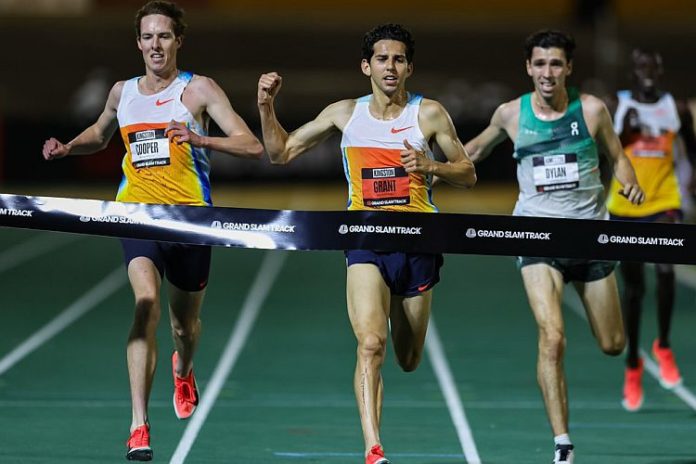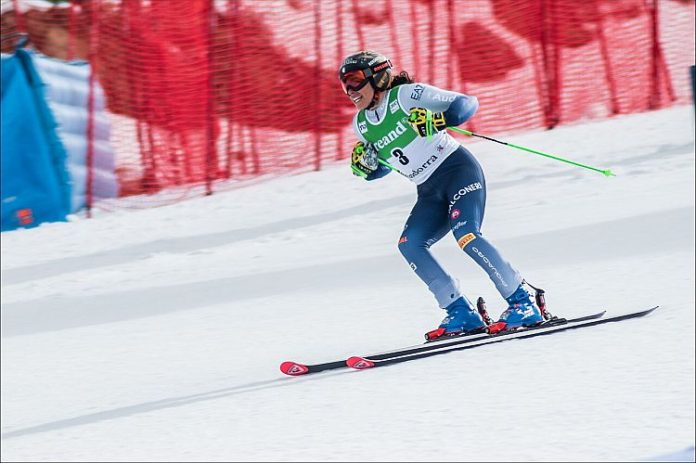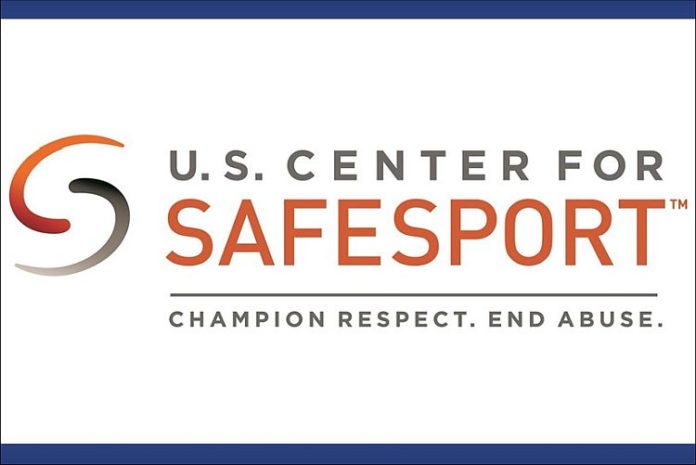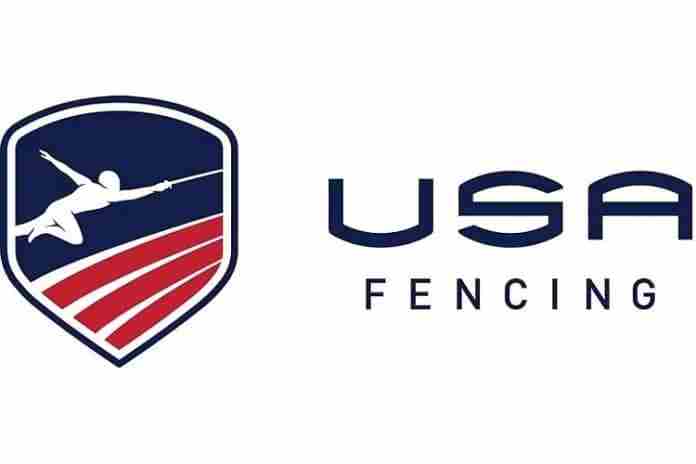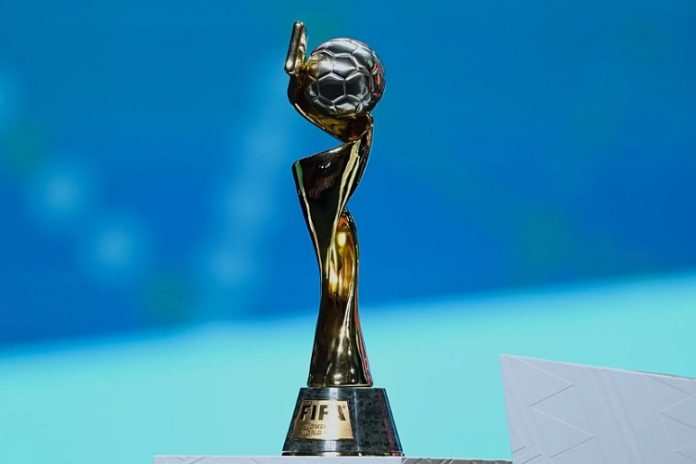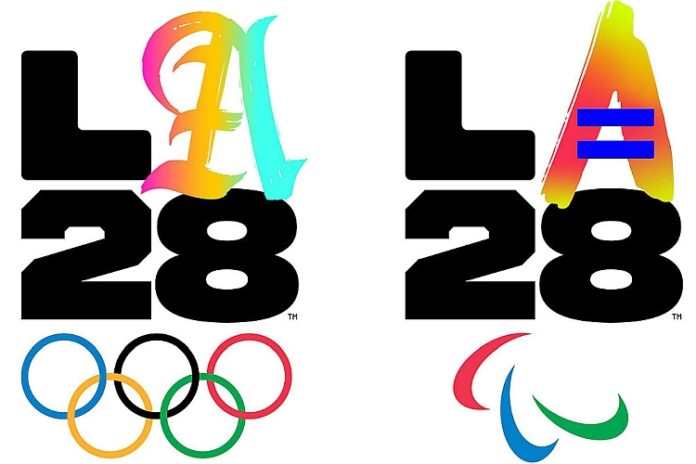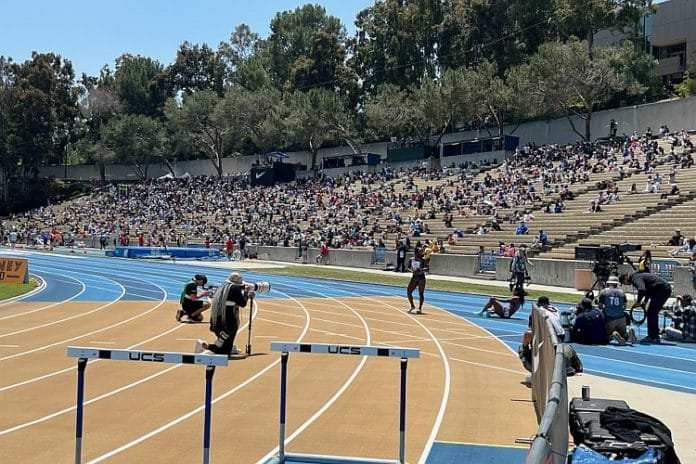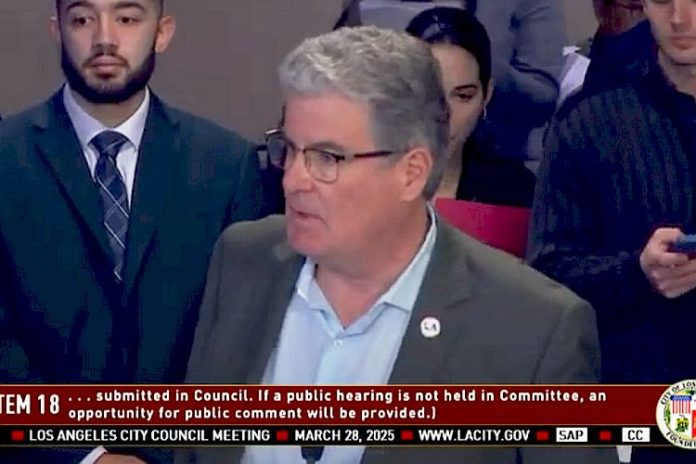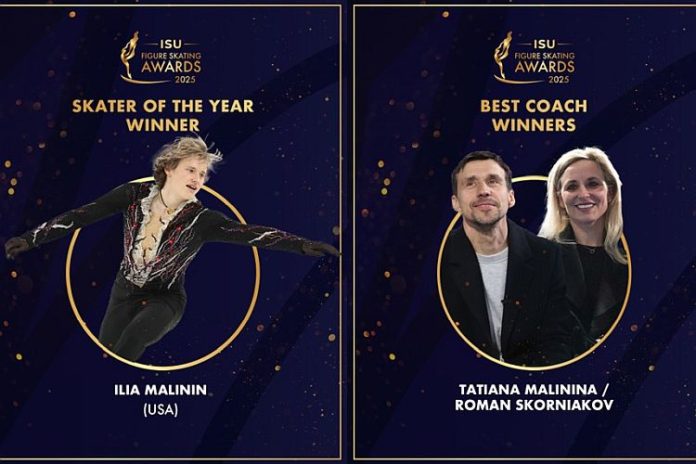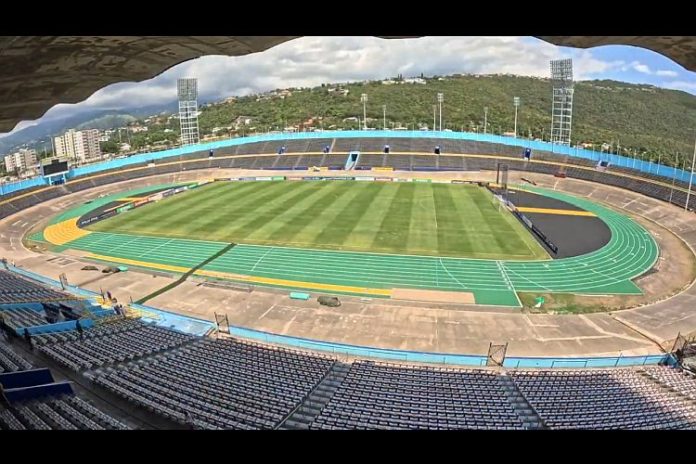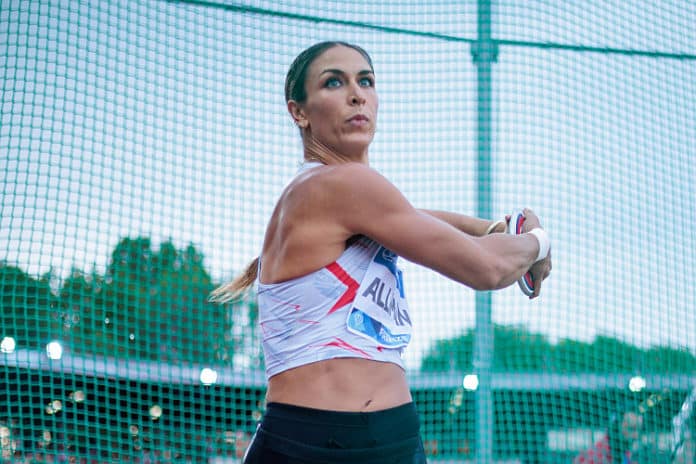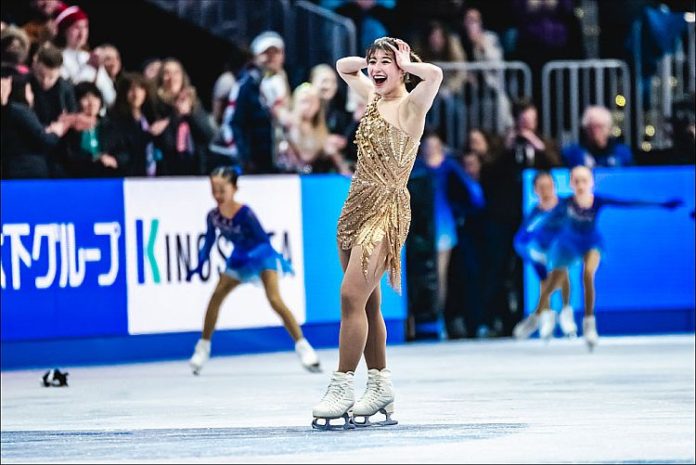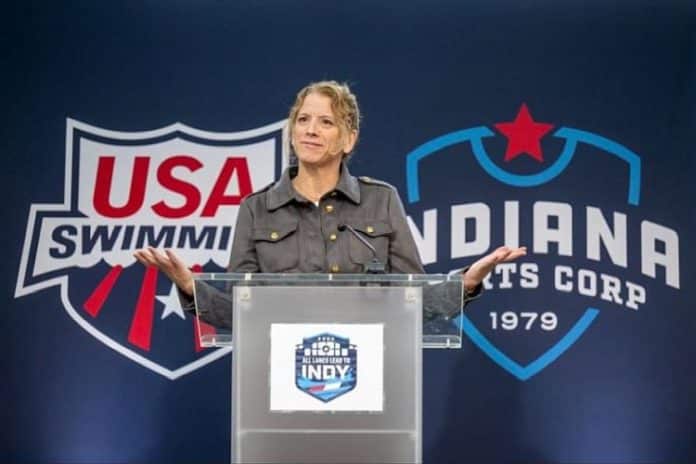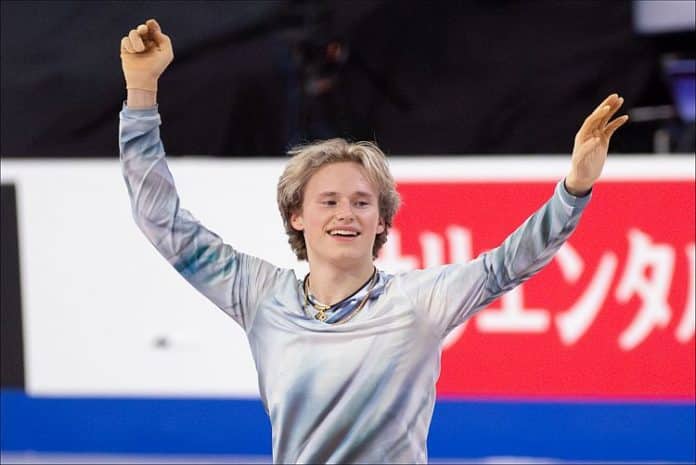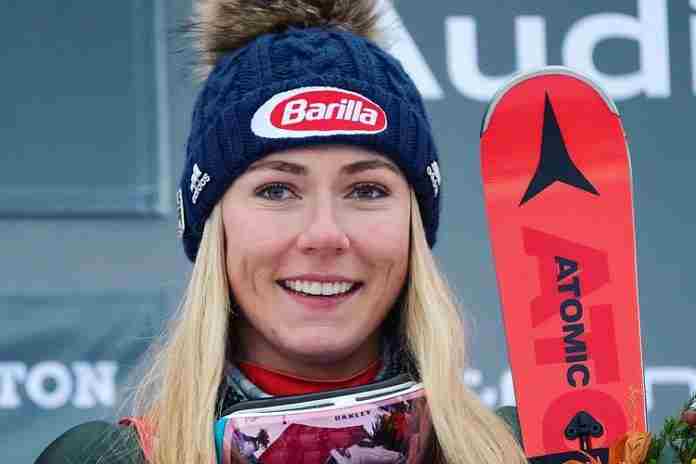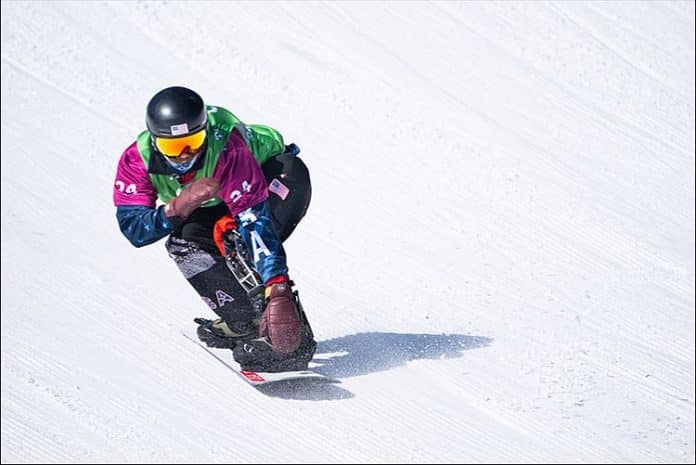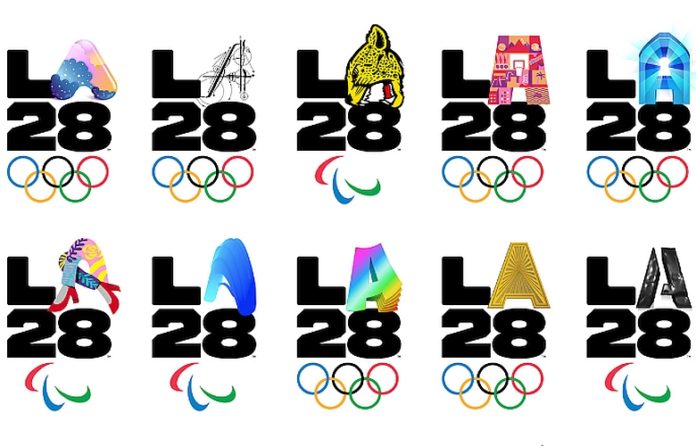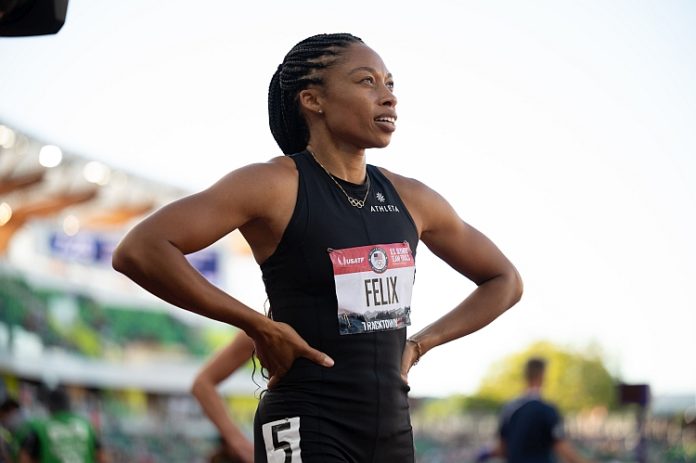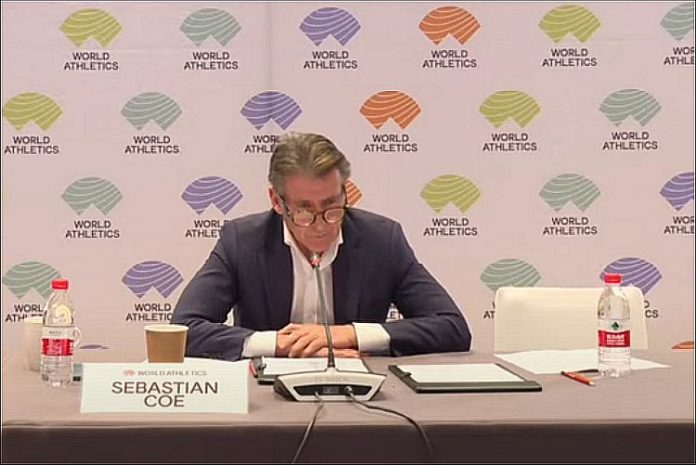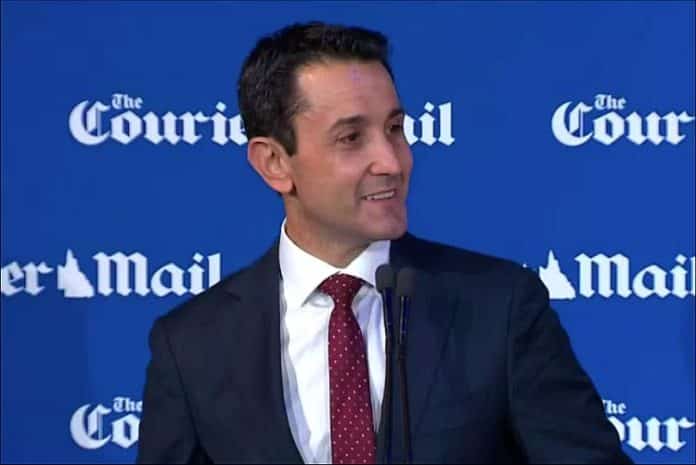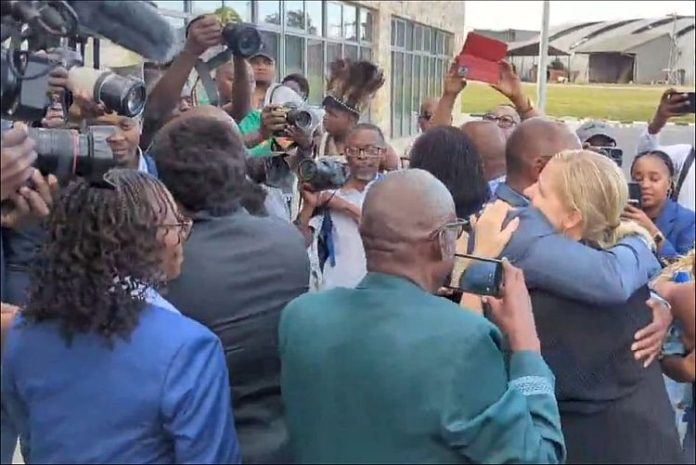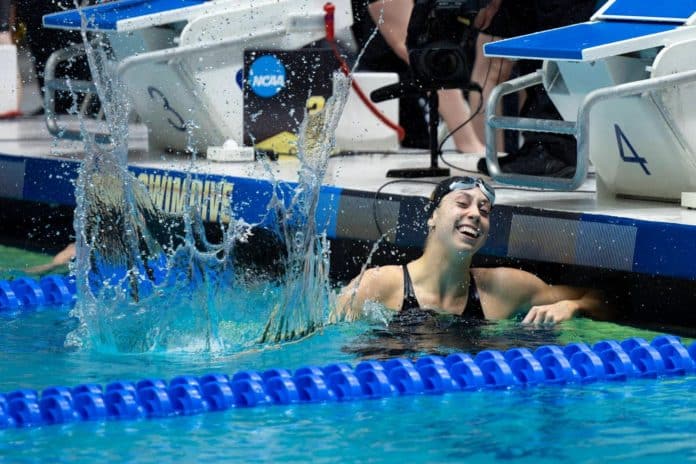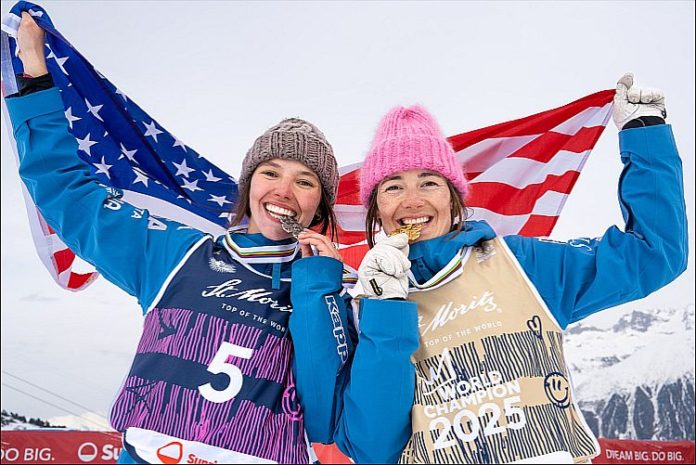★ The Sports Examiner: Chronicling the key competitive, economic and political forces shaping elite sport and the Olympic Movement.★
★ To get the daily Sports Examiner Recap by e-mail: sign up here! ★
≡ THE 5-RING CIRCUS ≡
● Olympic Games 2028: Los Angeles ● Oklahoma City Mayor David Holt has asked the City Council to approve a $34.6 million guarantee to the LA28 Olympic and Paralympic Games organizing committee in order to host the slalom canoeing and softball events.
The motion is scheduled for Tuesday, with the cost calculated by a projection of the amount it would take to relocate the events to the Los Angeles area in case of an Oklahoma City default.
Holt told The Oklahoman, “It’s not a check we expect to write out.
“From their perspective, we’ve committed to do this. They committed to the [International Olympic Committee] these events will happen. They are relying on us to keep the commitment they made.”
¶
Los Angeles City 15th District Council member Tim McOsker continued his rage against the LA28 organizers, trying to get the sailing competition moved from Long Beach to San Pedro, filing two more motions on Friday to compel reports from LA28 on commitments made in the November 2021 Games Agreement with the City.
One asks for a report in seven days by City staff on the current status of the “LA28 Community Business and Procurement Program and the Local Hire Program” and the other for a City staff report – in seven days – on the LA28 “Impact and Sustainability Plan.”
Both motions were referred to the City’s Ad Hoc Committee on the 2028 Olympic and Paralympic Games; the first motion was also referred to the Economic Development and Jobs Committee.
● Football ● On Thursday, FIFA announced a special ticket offer, tying purchases – and attendance – at FIFA Club World Cup matches this summer for tickets at the FIFA World Cup in 2026:
“This package involves one ticket per match to two FIFA Club World Cup 2025 matches, with the option to add one ticket to a third match at an additional cost. The purchaser of a Ticket Pack who uses all tickets to attend all matches included in their Ticket Pack will be granted a guaranteed option to buy one ticket to a FIFA World Cup 26 match in the United States (excluding the final).”
This is available for 25 days (from 3 April), or until the allocation runs out. There is also a “Super Ticket Pack:”
“A once-in-a-lifetime opportunity to enjoy the groundbreaking FIFA Club World Cup 2025, this package features one ticket per match to 20 FIFA Club World Cup 2025 matches, which must include a semi-final and either the opening match or the final. The purchaser of a Super Ticket Pack who uses all tickets to attend all matches included in their Super Ticket Pack will be granted a guaranteed option to buy one ticket for the eagerly anticipated FIFA World Cup 26 final.”
The Club World Cup kicks off on 14 June in Miami, Florida, with the final on 13 July in New Jersey.
● Gymnastics ● A total of 14 Russian artistic gymnasts received neutral status from the Federation Internationale de Gymnastique to compete in FIG World Cup events, but decided not compete. According to the Russian Gymnastics Federation:
“All Russian athletes representing artistic and rhythmic gymnastics, who have received neutral status, have decided to refrain from participating in the upcoming competitions under the auspices of the International Gymnastics Federation. The reason for this decision is the numerous unfounded and biased refusals by the FIG special committee to allow our gymnasts to compete.”
According to the Russian news agency TASS:
“[T]he FIG refused to grant neutral status to some athletes from Russia due to the posting of a congratulatory message on social networks for Victory Day, the athletes’ participation in a gala concert for Defender of the Fatherland Day, during which the St. George ribbon was used and photographs were taken with children in military uniform.
“Another reason for the refusal was the athlete’s subscription to a group on a social network where an announcement of the V All-Russian Anti-Doping Dictation, dedicated to the Physical Culture Day, was posted. The experts of the special FIG committee took the number V for one of the symbols of the SVO [Ukrainian invasion].”
● Skateboarding ● The Italian news agency ANSA reported that World Skate will impose a minimum age limit on athletes at the 2028 Olympic Games of 14, to be achieved by the end of the year (meaning 13-year-olds could compete in Los Angeles).
Athletes as young as 11 – China’s Haohao Zhang – competed in Paris in 2024; an age limit of 12 will be installed for the Youth Olympic Games.
≡ RESULTS ≡
● Athletics ● At the USATF National 10-mile Championships in Washington, D.C., held in conjunction with the annual Cherry Blossom 10, with former Oklahoma State All-American Taylor Roe backing up her win in the USATF Half Marathon champs in March with two American Records.
She surged away from the field after a couple of miles and won going away in a U.S. record of 49:53, destroying Molly Huddle’s 2018 mark of 50:52. Emma Grace Hurley was a distance second in 51:04 and Fiona O’Keeffe was third in 51:49.
Along the way, Roe passed 10 km in 30:56, four seconds off Shalane Flanagan’s 2016 best, but got a U.S. women’s-only record, ahead of Weini Kelati’s 31:18 in 2021. Roe also grabbed the American Record for 15 km at 46:24, slashing Kelati’s 46:32 from earlier in 2025.
The men’s race was won by U.S.-British dual citizen Charles Hicks in 45:14, with a final sprint to beat USATF Half Marathon champ Alex Maier (45:15) and Biya Simbassa (45:23). Maier claimed the American Record, one second better than Conner Mantz’s en route time during the Houston Half Marathon earlier this year.
● Curling ● Olympic silver medalist Bruce Mouat’s Scottish rink claimed their second World Curling Men’s World Championships in the last three editions in Moose Jaw (CAN) on Sunday.
Canadian star Brad Jacobs, the 2014 Olympic winner, had his rink at the top of the round-robin after an 11-1 record, ahead of the Swiss (9-3) and then China, Sweden and Scotland at 8-4.
In the playoffs, Mouat’s Scots dispensed with Canada’s Jacobs in the semis, 7-4, and Swiss Yannick Schwaller’s rink dumped China, 7-3. That set up the final, with the Swiss leading, 1-0, through four ends, but Mouat coming up with two in the fifth, only to see Schwaller match in the sixth. The Scots scored twice more in the seventh, but the Swiss tied it at 4-4 in the eighth.
Finally, a score in the 10th gave Mouat and Scotland a 5-4 win and the title, their seventh in history and the second for Mouat, who won with the same team as in 2023: Grant Hardie, Bobby Lammie, Hammy McMillan Jr. and Kyle Waddell.
Canada and Jacobs won the third-place game, 11-2, over China (Xiaoming Xu). The U.S., with Korey Dropkin as skip, finished 4-8, in 11th.
● Cycling ● The great Tadej Pogacar (SLO) did it again, riding away with another major race win, this time at the 109th Ronde van Vlaanderen – the Tour of Flanders – attacking with 18 km to go and winning over the 268.9 km course in 5:58:41.
That was 1:01 better than Mads Pedersen (DEN) and Mathieu van der Poel (NED), who ended up 2-3, with Wout van Aert (BEL) in fourth, with the same time. It’s Pogacar’s second win in this race, also in 2023.
The women’s race was won by home favorite Lotte Kopecky, winning a final sprint of four riders at the end of the 168.9 km track, in 4:24:34. She was just better than Pauline Ferrand-Prevot (FRA) and Liane Lippert (GER), both with the same time, and a second up on Kasia Niewiadoma (POL). It was the third win in this race for Kopecky, who took it in 2022 and 2023.
¶
Colombia and the U.S. led the way at the Pan American Track Championships in Asuncion (PAR), finishing 1-2 on the medal table.
In the men’s events, American riders won the Individual Pursuit (Anders Johnson), the Omnium (Peter Moore), Elimination Race (Brendan Rihm) and the Madison, with Moore and Rihm together, and they were both on the winning Team Pursuit squad. Rihm also got second in the Scratch Race behind Canada’s Cameron Fitzmaurice.
Trinidad & Tobago star Nicholas Paul won the Sprint and the Time Trial (and his team took the Team Sprint) and Peru’s Hugo Perez took the Points Race.
In the women’s finals, the star was Mexico’s Yareli Acevedo, who won the Scratch Race, Elimination Race and the Omnium. Colombia’s Stefany Quadrado won the Time Trial over Hayley Yoslov of the U.S., and Lina Hernandez and Elizabeth Castano won the Madison.
American Emily Ehrlich won the Individual Pursuit and rode on the winning Team Pursuit squad for the U.S. The American squad also took the Team Sprint. Canada’s Lauriane Genest took the Sprint and the Keirin.
In all, Colombia won 20 medals (3-10-7) and the U.S. had 13 (8-3-2).
¶
The UCI Mountain Bike World Series opened in Aranxa (BRA), with a stirring win for France’s Olympic runner-up Victor Koretzky, winning the Cross Country Olympic men’s race in 1:19:32, up 10 seconds on American Chris Blevins, the 2021 World Short-Track champ. Chile’s Martin Vidaurre was well back in third in 1:20:01.
Blevins won the Short Track race on Saturday over Koretzky, 21:40 to 21:41.
New Zealand’s Sammie Maxwell, the 2023 World U-23 gold medalist, took the women’s Cross Country Olympic gold with a big lead after seven laps, but losing some of her lead on the final circuit, winning in 1:24:03. Moving up were two-time Worlds relay winner Nicole Koller (SUI) and 2023 U.S. champion Savilla Blunck, who went 2-3, both in 1:24:07.
Britain’s 2024 World Short-Track winner Evie Richards won the women’s Short Track race on Saturday over Maxwell, 21:25 to 21:26.
● Diving ● China dominated the World Aquatics World Cup in Guadalajara (MEX), but the home team had some celebrations, too!
Paris Olympic silver winner Zongyuan Wang won the men’s 3 m Springboard easily at 540.15, way ahead of Juan Celeya (MEX: 457.45); American Luke Sitz was 10th (384.75). On the Platform, Mexico scored big with Randal Willars scoring 547.70 to overwhelm everyone, ahead of China’s Zifeng Zhu (468.65) and Zilong Cheng (463.80).
Mexico also got a win in the 3 m Synchro, as Celeya and Osmar Olvera scored 430.23 points to edge newcomers Yukang Hu and Jluyuan Zheng (413.16) and British veterans Anthony Harding and Jack Laugher (396.06). Sitz and Josh Sollenberger of the U.S. finished 11th (341.07).
The men’s 10 m Synchro was a close win for China’s Zilong Cheng and Zifeng Zho with 449.49 points to 435.45 for Mexicans Kevin Berlin Reyes and Willars. The American duo of Joshua Hedberg and Tyler Wills finished fourth at 388.71.
Jia Chen and Yiwen Chen went 1-2 in the women’s 3 m Springboard, scoring 380.55 and 372.90, beating Australian Olympic silver winner Maddison Keeney (352.00); American Sophie Verzyl placed seventh (302.25).
Yani Chang and Yiwen Chen took the women’s 3 m Synchro with 323.79 points to 296.08 for Lia Cueva and Mia Cueva (MEX) and Keeney and Alysha Koloi (AUS: 287.85) in third. Americans Kyndal Knight and Anna Kwong finished seventh in 237.60.
China’s Paris Olympic runner-up Yuxi Chen and Olympic champ Hongchan Quan went 1-2 in the women’s 10 m Platform, scoring 419.35 and 414.40, ahead of Britain’s 2024 Worlds bronze winner Andrea Spendolini Sireix (337.70). Daryn Wright was the top American, in ninth (271.80). In the women’s 10 m Synchro, Wei Lu and Minjie Zhang were clear winners at 347.58, ahead of Gabriela Agundez and Alejandra Estudillo (MEX: 316.62).
China – Zilong Cheng, Zongyuan Wang, Yiwen Chen and Yuxi Chen – won the Mixed Team event by 489.10 to 416.45 over Italy, with Germany third at 396.20. The U.S. was sixth at 372.20.
● Equestrian ● At the FEI World Cup Final in Basel (SUI), France’s Julien Epaillard and Donatello d’Auge sailed through the first two stages with no fault and in the third stage on Sunday, had no faults in the first round and only one error (4 points) in the second to end with just four overall and the victory.
That was just better than Ben Maher (GBR) and Point Break, who had just seven total points, and Kevin Staut (FRA) and Visconti du Telman (also 7, but slower in the final round). Katherine Dinan was the top American (13), with Out of the Blue, in eighth. Epaillard moved up from silver in 2024.
The Dressage Grand Prix Freestyle saw familiar winners. Britain’s Charlotte Fry, the Paris Olympic bronze medalist, won at 88.195% aboard Glamourdale, followed by German legend Isabell Werth – with DSP Quantaz – at 84.365%, with Isabel Freese (NOR, with Total Hope OLD) in third place at 81.850%.
Fry, Werth and Freese also went 1-2-3 in the Grand Prix Final a day earlier.
● Football ● The USA women met Brazil in a friendly at SoFi Stadium in Inglewood, California on Saturday, in a re-match of last summer’s Olympic final won by the U.S., but with a more emphatic outcome.
The Americans were on offense from the start, with immediate pressure. Midfielder Alyssa Thompson quickly found space, dribbling into the middle of the field and sent a lead pass to a cutting forward Trinity Rodman in front of the goal and she sent a right-footed toe-tap into the right side of the Brazilian goal at the five-minute mark. It was Rodman’s first game since the Olympic final against Brazil in Paris last year, thanks to a back injury.
Thompson almost got a goal herself in the 17th, as her shot from the top of the box toward the far right side of the Brazilian goal was saved by keeper Lorena. The U.S. had more chances, from forward Ally Sentnor (18th) and Rodman (22nd), but Lorena was equal to those challenges.
Brazil had chances too, with striker Amanda Gutierres challenging U.S. keeper Phallon Tullis-Joyce in the 30th, but Tullis-Joyce handled it; she stayed busy throughout the half. Possession was 50-50 in the half, but Brazil ended with a 9-6 edge on shots.
The U.S. came out with more control in mind in the second half, but Brazilian midfielder Ludmila hit the U.S. goal post with a shot in the first minute. Brazil got off three more shots on Tullis-Joyce by the 62nd minute before the U.S. offense got going, and in the 66th, Ludmila tackled Lily Yohannes in the box for a penalty.
Midfield star Lindsey Heaps calmly shutter-stepped, then a right-footed smash (barely) into the left side of the Brazilian net for the decisive 2-0 lead. From that point, the U.S. maintained most of the control and the game finished at 2-0.
With better possession on the ball in the second half, the Americans finished with 55% of the ball and had 16 shots to 15 for the visitors. They will meet again on Tuesday in San Jose, California.
● Gymnastics ● At the FIG Rhythmic World Cup in Sofia (BUL), Ukraine’s Paris Olympic ninth-placer Taisila Onofriichuk took the All-Around, scoring 114.450 across two rounds, ahead of Bulgaria’s six-time Worlds medal winner Stiliana Nikolova (110.65) and Uzbek Takhmina Ikromova (109.850). Rin Keys and Megan Chu were the American entries, in sixth (107.000) and eighth (106.500).
In the apparatus finals, Nikolova won on Ball (28.950) and Hoop (29.500) and Onofriichuk took the wins in Clubs (28.900) and Ribbon (27.450). Keys qualified for the Ball final and was sixth (25.350); also sixth in Clubs (26.200), then scored a bronze on Ribbon (26.950), while Chu placed seventh (24.100).
¶
At the Trampoline World Cup in Riccione (ITA), a re-match of the Paris 2024 Olympic men’s final saw gold medalist Ivan Litvinovich (BLR) win again over China’s Zisai Wang, 66.390-65.400.
The women’s final had Paris Olympic finalist Yicheng Hu (CHN) winning with 57.030 points, edging Sofiia Aliaeva (BLR: 56.600), with Canada’s Olympic bronzer Sophiane Methot third (55.310).
Americans Isaac Rowley and Cheyenne Webster won the Mixed Synchro (48.210); German 2023 World Champions Fabian Vogel and Caio Lauxtermann won the men’s Synchro (51.570) and Britain’s 2023 Worlds bronze medalists Bryony Page and Isabelle Songhurst took the women’s Synchro (50.000).
● Rugby Sevens ● At the Rugby Sevens Series in Singapore, a surprise in the men’s final and more of the same for the women.
The men’s pool winners were Argentina, Kenya, Spain and Fiji, and Fiji and Kenya romped into the final, with Fiji winning its second tournament of the season, 21-12 in the final. Argentina defeated Spain, 33-14, for third. That leaves Argentina still on top of the standings, heading to the Grand Final in Carson, California, with 114 points to 96 for Fiji and 88 for Spain. The U.S. finished 12th and did not advance to the Grand Final.
In women’s play, New Zealand, Australia, Canada and France all went 2-0 to win their pools. Then the Black Ferns stormed through the playoffs, winning their games by 40-14 over France and then 31-7 against Australia to win their third tournament in a row. Canada beat France, 21-5, for third.
So, New Zealand stays on top of the standings at 116 points to 106 for Australia, with France third at 80. The U.S. stands sixth (58) and qualifies for the Grand Final.
● Sailing ● The 54th Trofeo Princesa Sofia – for Olympic classes – off Palma de Mallorca (ESP) was a resounding success for Great Britain, which won five of the 10 classes and claimed nine medals overall (5-2-2), well ahead of Italy (0-4-1).
Australian Olympic silver winner Grae Morris took the men’s IQ Foil class win, turning back 2023 Worlds bronze medalists Nicolo Reina (ITA) and Adrien Mestre (FRA) in the final. Olympic bronzer Emma Wilson (GBR) won the women’s final, beating Zheng Yan and New Zealand’s Veerle Ten Have.
Two-time World Champion Maximilian Maeder (SGP) won the men’s Formula Kite class easily, winning the final over Riccardo Pianosi (ITA) and Valentin Bontus (AUT). Maeder piled up 15 wins across his 21 races. China’s Li Wan took the women’s Formula Kite, winning the final over 2023 Worlds bronze winner Lily Young (GBR) and 2024 Olympic champ Ellie Aldridge (GBR).
British boats went 1-2 in the men’s Laser (ILCA7) class, with 2023 Worlds runner-up Michael Beckett (45 net points) and Elliott Hanson (77) finishing ahead of Ireland’s Finn Lynch (81). The women’s Laser Radial (ILCA6) had Australia’s Zoe Thomson winning a tight duel with Emma Mattivi (ITA), 85-94, with Britain’s Daisy Collingridge a close third with 100 points.
Erwan Fischer and Clement Pequin (FRA), 12th at the 2024 Olympic regatta, won the men’s 49er class, with 80 net points to 94 for Germans Richard Schultheis and Fabian Rieger. Nevin Snow and Ian MacDiarmid of the U.S. finished sixth (138).
Britain’s Freya Black and Saskia Tidey took the women’s 49erFX title, winning three races and placing third in the medal race to edge Johanne Schmidt and Andrea Schmidt (DEN: 79) and Pia Dahl Andersen and Nora Edland (NOR: 105).
And British stars John Gimson and Anna Burnet, two-time World Champions, won the Nacra 17 class by winning the medal race, to give then a 43-45 victory over Gianluigi Ugolini and Maria Giubilei (ITA), who finished sixth. China’s Huancheng Zhao and Su Sha were right behind with 47 points, finishing fifth in the medal race.
Britain’s Martin Wrigley and Bettine Harris were easy winners in the mixed-crew 470, with six top-three finishes and 31 net points, to 59 for Simon Desch and Anna Markfort (GER: 59).
● Ski Mountaineering ● At the penultimate ISMF World Cup of the season, in Villars-sur-Ollon (SUI), two-time seasonal men’s World Cup champ Thibault Anselmet (FRA) won the men’s Sprint in 2:27.6, ahead of Swiss Jon Kistler (2:32.9) and Maximilien Drion du Chapois (BEL). It’s Anselmet’s first win of the season.
The women’s Sprint went to France’s Sprint star Emily Harrop for her sixth World Cup win of the year, in 3:09.3, over Italians Giulia Murada and Katia Mascherona.
The Mixed Relay was won by Spain’s Ana Alonso and Oriol Cardona Coll in 33:18.2, just ahead of Marianne Fatton and Thomas Bussard (SUI: 33:19.4). The U.S. entry of Hali Hafeman and Griffin Briley finished 10th (+3:41.5).
● Snowboard ● The FIS World Cup seasonal finale in Snowcross was in Mont-Sainte-Anne (CAN), with the 2024-25 champions ending with victories.
Jakob Dusek (AUT) took Saturday’s men’s race for his second win of the season, just ahead of Olympic runner-up – and seasonal champion – Eliot Grondin (CAN) and American Nathan Pare, 20, who won his first World Cup medal!
The Sunday finale had Grondin finishing the season with a win, over Aidan Chollet (FRA) and Loan Bozzollo (FRA) and totaling 684 points for the Crystal Globe. Bozzolo finished second with 473 and Dusek was third at 444.
Saturday’s women’s winner was the third win of the season for France’s Lea Casta, 19, over Mia Clift (AUS) and Sina Siegenthaler (SUI), and gave her a 705-622 lead in the Crystal Globe standings over Britain’s 2021 World Champion Charlotte Bankes.
Casta won on Sunday, too, to complete her championship season, beating Siegenthaler and Clift and ending with 805 points to 622 for Bankes, with Julia Pereira de Sousa (FRA: 474) third.
● Swimming ● The second Tyr Pro Swim Series meet of the year was in Sacramento, California, saw a headline performance from American Luca Urlando and a world-leading mark from Australian distance star Sam Short.
Paris Olympian Urlando won the men’s 200 m Butterfly in a world-leading 1:52.37, moving him to no. 4 on the all-time list and no. 3 in American history. He said afterwards:
“That was so cool, I was not expecting that at all. The last 15 meters, I was tightening up a bit, so I was telling myself to just hold my stroke together.”
Short, the 2023 World Champion in the 400 m Freestyle, won three events, taking the 400 m Free in a world-leading 3:43.84, and the 800 m Free (7:46.99) and 1,500 m Free (15:03.87).
The biggest winner was France’s Maxime Grousset, the 2023 Worlds 100 m Fly winner, who tied with U.S. star Michael Andrew to win the 50 m Free (22.04), won the 100 m Free in 48.20, the 50 m Fly (23.12) and 100 m Fly (51.30), beating Urlando (51.32).
Also taking three wins was fellow Frenchman Yohann Ndoye Brouard, a Paris relay bronze medalist, in the backstrokes: 50 m (25.37), 100 m (53.87) and 200 m (1:59.49). Denis Petrashov (KGZ) won two events, the 50 m Breast in 27.32 and 100 m Breast (1:00.42), both times beating Andrew.
American Brooks Curry won the 200 m Free in 1:46.74 (with Short third); Matthew Fallon took the 200 m Breast in 2:09.58) and Grant House (1:58.22) and Michael Hochwalt (4:16.88) won the 200 and 400 m Medleys.
The women’s star was New Zealand’s Eve Thomas, who took the 400 m Free (4:11.64), 800 m Free (8:39.32) and 1,500 m Free in 16:30.48. Two-event winners included French sprinter Beryl Gastaldello, who took the 50 m Free (24.75) and 100 m Free (54.01), American Rhyan White – a Tokyo Olympic relay silver winner – won the 100 m Back (59.68) over Paris Olympic 100 m Back bronze Katharine Berkoff by 1/100th, and won the 200 m Back (2:08.83); she was second in the 50 m Back (27.91) to Berkoff (27.83).
Hungary’s Aliz Kalmar was the other two-event winner, taking the 50 m Breast in 31.56 and the 100 m Breast (1:07.91). Americans Leah Shackley (58.75) and Rachel Klinker (2:10.85) won the 100-200 m Flys; Israeli Olympian Anastasia Gorbenko won the 200 m Medley in 2:09.90 and Swede Lisa Nystrand took the 400 m Medley in 4:45.02.
¶
The USA National Open Water Championships were in Sarasota, Florida, with 16-year-old Brinkleigh Hansen winning the women’s 10 km title and qualifying for the World Aquatics Championships. She won a tight battle with 18-year-old Paris Olympian (and 4×200 m Free relay silver winner) Claire Weinstein, two seconds behind, 2:04:09 to 2:04:11. Mariah Denigan was third in 2:04:16. Hansen and Weinstein qualify for the World Championships; Weinstein and Denigan went 2-3 for the second straight year.
Australia went 1-2 in the men’s 10 km as guest swimmers, winning a five-way final sprint, with Kyle Lee and Thomas Raymond both timed in 1:53:38. Dylan Gravely was the top American, in third place, close behind in 1:53:40, with Joey Tepper at 1:53:41; as the top two Americans, they also qualified for the Worlds. Gravely won the U.S. 5 km title in 2024 and moved up from third in the 10 km from last year.
In Sunday’s 5 km nationals, Paris 2024 Olympian Ivan Puskovitch out-touched defending champion Gravely in the men’s race, 56:10 to 56:12, with Japan’s Riku Takaki third in 56:22. Weinstein was a dominant winner in 1:01:33 over defending champ Ichika Kajimoto (JPN: 1:02:14) and Denigan (1:02:15) in the women’s.
● Table Tennis ● At the WTT Champions in Incheon (KOR), China swept the Singles titles, with Peng Xiang sweeping the men’s final, 4-0, over Sang-su Lee (KOR) by 11-8, 11-0, 11-3, 11-4.
The women’s final went to top-seeded Yidi Wang, the 2021 Worlds bronze medalist, who defeated countrywoman 2023 Worlds bronze medalist Xingtong Chen by 4-3 in a major comeback: 11-9, 8-11, 9-11, 12-14, 11-9, 11-6, 12-10.
¶
★ Receive our exclusive, weekday TSX Recap by e-mail by clicking here.
★ Sign up a friend to receive the TSX Recap by clicking here.
★ Please consider a donation here to keep this site going.
For our updated, 694-event International Sports Calendar for 2025 and beyond, by date and by sport, click here!


